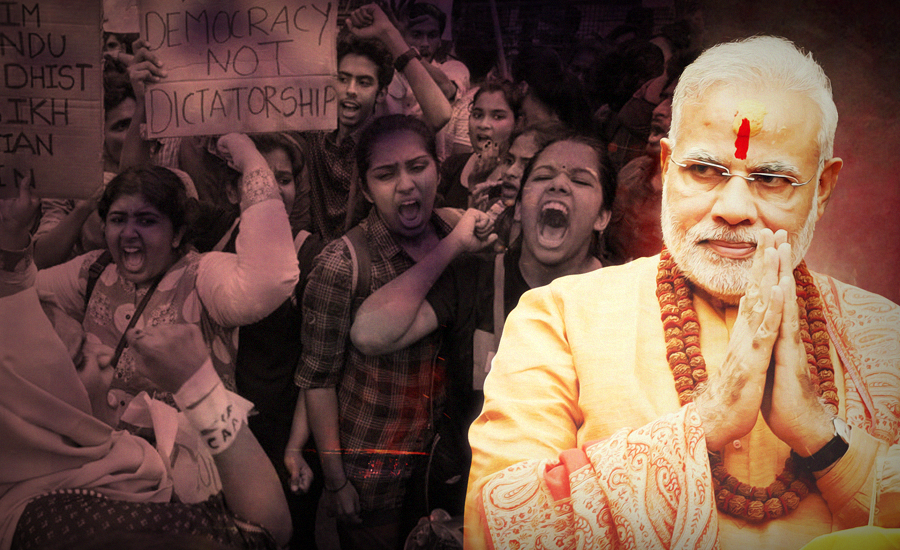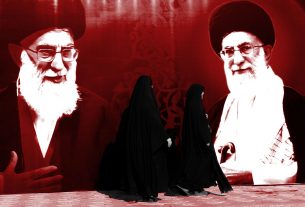Tue 28 January 2020:
Pro-government media and politicians have cast the protesters as paid anti-India agents, but that’s far from the reality driving the demonstrations.
The passage of the Citizenship Amendment Act (CAA) has led to one of the longest and most intense citizen-led, anti-government mobilizations in India in the last decade. Deemed discriminatory in nature, the Act in conjunction with the proposed National Register of Citizens (NRC) has propelled fears that the Narendra Modi-led Bharatiya Janata Party (BJP) seeks to undermine the constitution’s secular character and turn India into a majoritarian state. Over the last month and a half, ordinary citizens have thronged the streets of major cities across India and embarked on sit-ins and protest marches to oppose the Act. One such peaceful and leaderless protest that has generated massive public attention involves the brave women and men of Shaheen Bagh, a predominantly Muslim majority locality in the national capital, Delhi.
Primarily led by women, the Shaheen Bagh sit-in has become a site of modern day Satyagraha, a Gandhian method of agitation for truth and justice against the brute power and oppression of the current regime. After the passage of the CAA, massive student-led rallies rocked the national capital, including at Jamia Millia Islamia University. The police resorted to a violent crackdown to crush the protests, even breaking into the university library to beat up students. On December 15, the women of the area began a 24/7, non-violent peaceful sit-in at Shaheen Bagh to protest against the CAA and NRC. The protest has grown in numbers over the last month, attracting thousands of supporters from across the country. Most importantly, Shaheen Bagh has inspired similar women-led sit-ins across the country, including in Prayagraj, Kanpur, Kolkata, Patna, and Gaya among others.
These modern-day Satyagrahis of Shaheen Bagh have become a thorn in the side of the right wing in India. The ruling cadre has aggressively tried to defame and discredit the protests at Shaheen Bagh. The BJP IT Cell head Amit Malviya even claimed that the women at Shaheen Bagh were paid 500 to 1,200 rupees daily along with promises of refreshments by the Congress party to stage protests at the venue. In order to create a sense of “otherness,” leading pro-government news channels have tried to paint the protestors as anti-national, pro-Pakistani, and supporters of Muhammad Ali Jinnah through fake videos and scintillating propaganda aired in prime time slots. Right wing personalities even tried to portray the Shaheen Bagh protestors as supporters of the plight of Kashmiri Pandits, who were forced to leave in the late 1990s with the rise of separatism and militancy in the valley.
There are two primary factors that drive the right wing’s diatribes against the protests at Shaheen Bagh.
First, the spontaneity and politically independent nature of the protests marks the first of its kind of agitation against the popular reign of Narendra Modi. The BJP fears that the protests may snowball into a stronger national sentiment against the government, thereby strengthening the opposition. It should be noted that the BJP returned to power in 2014, after a 10-year hiatus, by riding high on the Anna Hazare-led “India Against Corruption” movement. The corruption scandals of the second United Progressive Alliance government combined with stifling policy paralysis evaporated Manmohan Singh’s political capital. Amid the rising national profile of Narendra Modi as the undefeated chief minister of Gujarat post-2012, the BJP-Rashtriya Swayamsevak Sangh combine was quick to hijack the anti-corruption drive of Anna Hazare. It supported the movement against an entitled leadership of the Gandhi family, thereby filling up the political vacuum with Modi as a self-made leader of the masses.
Currently, the powerful image of the women of Shaheen Bagh and their ability to inspire thousands of women across the country raises warning signs for the ruling party. Although Modi enjoys massive support, unlike UPA II, and was able to ensure a decisive victory at the general elections last year, the party has been losing ground in major state elections since December 2018. The symbolism of Shaheen Bagh endangers the party’s prospects in the Delhi assembly elections, scheduled for February, where the party already faces one of its toughest competitors in Arvind Kejriwal. And more importantly, a spontaneous, people-led movement in the heart of the national capital strikes at the core of the BJP’s carefully cultivated imagery of political hegemony.
Second, the very idea of Shaheen Bagh demonstrates an antithesis to the principles of Hindutva. It has worked as an antidote to the majoritarian impulses of the government and its supporters by bringing together people from different communities at the protest venue. For example, Shaheen Bagh has witnessed Sikhs chanting their religious slogans, Muslims offering their prayers and Hindus performing their sacred fire ritual, and more as an expression of communal harmony over the last few days. The women of Shaheen Bagh raise slogans such as Hum Ek hain (“We are one”) affirming the oneness of Indians, irrespective of their social identities. The national flag and pictures of national icons such as Mahatma Gandhi and Dr. Bhimrao Ramji Ambedkar adorn the venue as a firm display of the protestor’s commitment to India’s secular, constitutional democracy.
The expression of togetherness and solidarity from Shaheen Bagh continues to irk the establishment. The basis of unleashing the CAA-NRC lies in successfully polarizing communities and reaping electoral and political benefits from such actions. Unfortunately, Shaheen Bagh exists as a thriving island of secularism with the potential to inspire citizens across the country. And the driving forces of this island are the peaceful women of Shaheen Bagh, who have taken a lead in voicing their country’s anger against a majoritarian government.
The right wing onslaught on Shaheen Bagh is a testament to its resilience and courage. As the country seethes amidst fears and confusion over the CAA-NRC, the pages of India’s history shall register the women of Shaheen Bagh as role models of democratic dissidence and leaders of the voiceless.
Avishek Jha is a Research Associate with the Trivedi Center for Political Data, Ashoka University.
-Source: thediplomat
The statements, views and opinions expressed in this column are solely those of the author and do not necessarily represent those of Independent Press.
Think your friends would be interested? Share this story!





